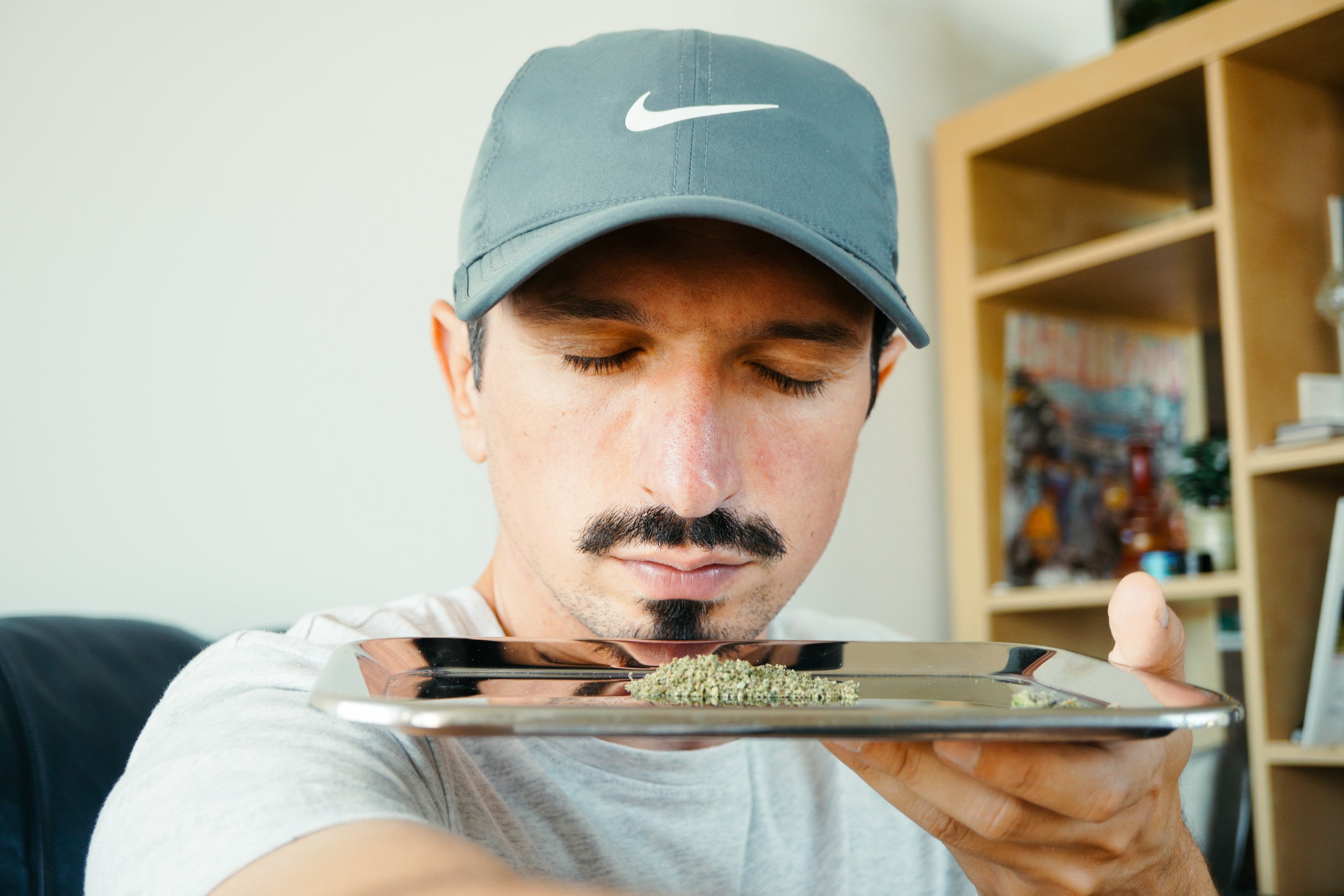Cannabis sensory guide
Cannabis sensory guide; How to smell and taste terpene profiles.
Despite this mystical plant being intimately interwoven with human society for thousands of years, we are only now starting to unravel the complexity of the relationship between us and cannabinoids. Through science, we are slowly starting to get a clearer picture of how these elements interact and play with each other, and what are their effects on people when consumed. Though we might get some definitive answers about certain subjects, much of the fun, appreciation and experience is very personal and subjective, making it almost impossible to quantify in a scientific way. Because we are all different, we experience cannabis differently. However, there are some general rules and tips to help you better understand what you're consuming, and if it meets your standards of quality. Your senses of smell and taste are a vital part of this experience. To help guide you on this journey, we wrote a non-scientific but detailed guide on how to smell and taste different terpene profiles in a way that can help you achieve a more nuanced experience.
Understanding terpenes:
One of the first things to understand about weed is that the smell and taste, as well as much of the experience as we are coming to find out, comes largely from the terpenes. These volatile compounds are made of unsaturated hydrocarbons which are produced by most plants. There are over 400 individual terpenes and each one has its own particular smell and taste but when combined with other terpenes, they create specific profiles which can be easily identifiable with enough experience. Floral, fruity, gassy, creamy, and spicy are some of the main profiles found in cannabis. The overlap and nuances are never ending with each strain, phenotype as well as the garden from which it came from producing a unique profile. These terpenes are activated by heat, which causes them to evaporate and release the beautiful smells as they waft away. This is why smelling your cannabis is very important and a major key into understanding the product. Now that we got the terpenes out the way, let's take a closer look.
Bag smell:
When you first crack your bag or jar open, you can take an initial whif to get first impressions. Please keep in mind that the product might have been sitting in this container for some time and this could possibly affect your initial judgment as this might have slightly altered the smell of the dried flowers. This is why its important to let it sit open for about a moment to allow the aromas to settle and regain their true form. You can then close the container for a couple of minutes or however long, and re-open it again to get a second impression. The intensity of the smell largely depends on how much cannabis is in your container, how strong the terpenes are and at what temperature they are sitting. Warmer temperatures tend to give off a way louder and pronounced smell to the flowers compared to a cooler temperature which tends to preserve the terps. So if it's not smacking you in the face at first, don't be bummed-out, if it was stored in a cooler climate it may take time for the flowers to acclimate to the ambient temp and it will shine harder if the temps are warmer. Take some time to contemplate the different nuances coming out of the bag and give it some time as these smells are constantly changing and evolving from the outside variables. At first you might get some sharper notes, but after some time, the deeper undertone will start coming out, spreading in your vicinity. Understanding profiles takes patients and nuance so take your time and try to identify all the instruments these terpenes are playing.
Bud Smell:
After you get to know your product in its container, pick some of the flowers up and take a good visual inspection. What you want to see are lots of juicy, shiney, unbothered trichome heads. Let the bud sit in your hand for just a bit to get it closer to your body temp as this will help bring out its profile.Take a few nice deep breaths with it really close to your nostrils. You might start noticing a whole new set of smells that you initially didn't catch when you first opened your bag. When you're done smelling the whole flower, crack one of them in half and take a nice deep smell in the section where you just snapped it. Typically, breaking and squeezing the bud will activate and burst the trichomes which will release a potent dose of terpenes locked inside. This should give you a nice representation of the terpenes that are less volatile but are quite pronounced when provoked. Take a few deep breaths and then allow yourself a moment of reflection to understand the nuance in this experience. What are you smelling, what does it remind you of, and what do you like or dislike about it?
Ground flowers:
After you're done breaking it apart and smelling it, make sure to separate the leaf and stems before throwing it in your grinder. This will ensure maximum, unadulterated flavour when smoked. For this final smell test, you will grind the flower to a consistent fine texture and examine it when you dump it out on your rolling tray. What you want to see is somewhat of a "Kinetic Sand" type of texture where the ground herb is magically sticking to each other as if it was slightly magnetic. This usually means your resin is greasy and full of flavonoids, and your flower is at optimal humidity levels, which is a good thing. Lift the tray closer to your nose and let it sit about four inches away from your nostrils. Give it a few seconds and take a couple of nice deep breaths to contemplate this final stage of your smelling experience.Take some time to identify the different notes by relating them to other things that remind of similar smells such as pine sap, orange peels, fruit punch, gasoline, ice-cream, mangoes, black pepper etc. Understanding these overlapping nuances of aromas can be a very powerful tool for future experiences as you might notice that some specific profiles speak to you a lot more than others.
Dry pull:
When rolling up, try using an unbleached rolling paper that is very thin and consistent for optimal flavour. We strongly suggest not to mix your premium flowers with tobacco or any other smokable additives in order to get the full tasting experience. Once you have rolled your joint, take a few good dry pulls before lighting it.If the flavour is coming through, nice and strong, it's a good indicator. After a few dry-pulls, you're ready for the tasting segment of this experience.
Taste test:
Once you spark the joint, you want to make sure the cherry gets nice and hot, burning evenly all around. Establishing a solid chery is key for optimal flavour enjoyment. Once the cherry is solid, you can take a nice pull, followed by a slight pause and then the exhale. One of the interesting aspects you might notice is that the inhale and exhale can taste differently from each other. Just like the smell, the taste reveals itself in steps and stages. If you're comfortable, feel free to play with the smoke and inhale or exhale through the nostrils, they might pick up something your mouth didn't. If you find it particularly tasty, try to identify what makes it so appealing to you? If the flavour is not satisfying, missing or just simply not speaking to you, try to remember the smell profile for future references. Typically, a solid strain should taste strong throughout the entirety of the joint. Feel free to observe the ash color and consistency. Clean, white and consistent ash is always optimal.
Final thoughts:
Much similar to wine and other spirits, the cannabis experience is not one dimensional, it's actually quite complex and multi-layered. It's also very vast with something to offer every taste pallet. Some people lean towards fruity flavours, others swear by the gas, most people can enjoy a dank kushy strain and a few won't smoke anything that has the haze profile. Sometimes you love the way it smells but hate how it tastes, and vice versa. The beauty of cannabis is diversity but in the midst of abundance, some profiles stand out and speak to certain individuals more than others. This is why it's important to give the experience a thought and try to understand the specific markers that spoke to you so profoundly. A little observation and reflection can go a long way when it comes to qualifying and enjoying fine products such as high-end cannabis. Hope this helps you understand some of the aspects of this process. Please, always consume responsibly and with respect.
Cheers!









